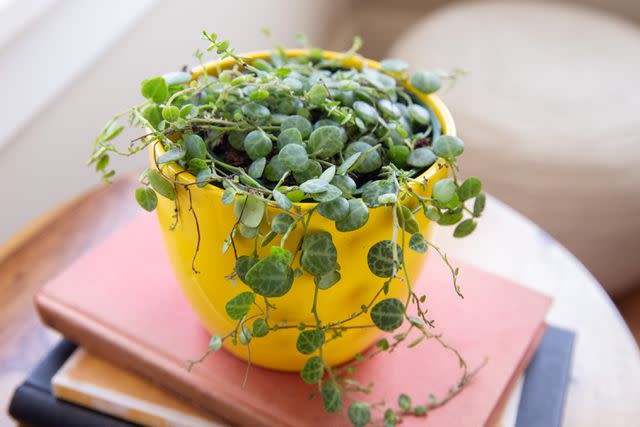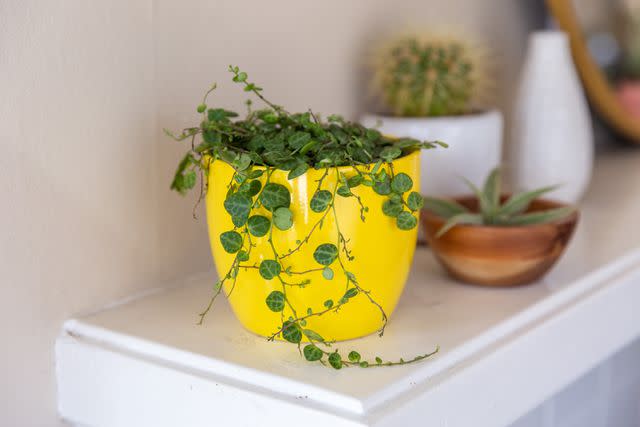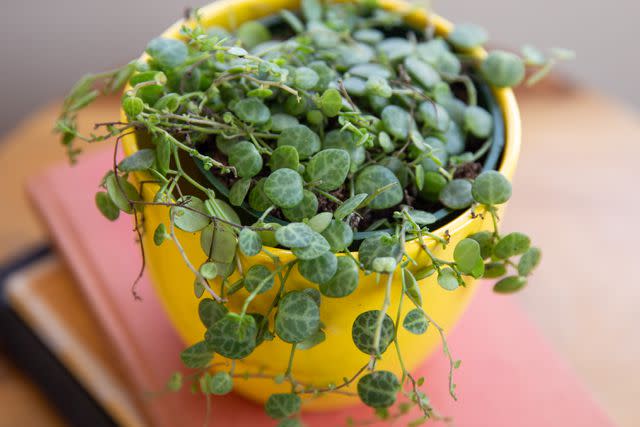How to Grow and Care for String of Turtles
Reviewed by Julie Thompson-Adolf
String of Turtles (Peperomia prostrata) is a type of succulent native to Brazilian rainforests that thrives in warm climates but adapts well to average household conditions. Because of this, it's a popular plant for houseplant collections and apartment jungles worldwide.

The Spruce / Krystal Slagle
That same leaf shape is what gives the plant its common name. Each one looks like the shell of a miniature turtle strung together. Every tiny leaf on its trailing vine has intricate multi-colored patterns covering its surface—the colors become muted with age and eventually become bicolored by maturity, typically a darker green contrasted by light green. No matter how it is used, the uniqueness of Peperomia prostrata will make it a valuable addition to any indoor plant collection and an excellent conversation piece.
Common Name | String of Turtles |
Botanical Name | Peperomia prostrata |
Family | Piperaceae |
Plant Type | Semi-succulent |
Mature Size | 12 in. long, 3-4 in. wide |
Sun Exposure | Bright, indirect light |
Soil Type | Loamy, moist |
Soil pH | Neutral to acidic |
Hardiness Zones | 10 to 12, USA |
Native Area | Brazil |
How to Grow and Care for String of Turtles Plant
When properly cared for, a string of turtles plant can be the pride of a tropical plant collection, but it will take a little effort and some adapting from the typical methods used to maintain most succulents. Different, though, does not mean complicated. An adequately cared for Peperomia prostrata will reward owners with a unique, well-kept, vining succulent.

The Spruce / Krystal Slagle

The Spruce / Krystal Slagle
Light
String of turtles plants love bright indirect sunlight and will thrive in these conditions. Keeping these plants in full sun for too long will damage the leaves, but too little light and they will fail to produce new growth. Because of the vining nature of the plant, make sure light reaches the top of the plant so that it continues to produce new growth. Often, vining plants are placed on high shelves or areas without light, which causes the plant to stop producing new growth. Make sure light reaches all areas of the plant.
Soil
The string of turtles needs well-draining, acidic soil consisting mainly of organic matter. One that is rich in peat is ideal. This formula is easily found in a commercial seed starting mix. Peat is acidic and perfect for this plant, but be careful not to let the pH get too low. Testing the soil every so often is a good idea.
Water
The string of turtles plants prefers slightly moist conditions. The species tends to suffer from overwatering more than they do from dry conditions. Ensure the pot has drainage holes, then water well letting the soil dry out between waterings.
Avoid overwatering by drenching the soil till water runs out the bottom of the pot and the soil is thoroughly moist. Do not water the plant again until the top two inches of soil have dried.
Temperature
Your string of turtles plant enjoys a consistent temperature of 68°F to 75°F. It does not like cold temperatures, so avoid placing it near exterior doors or drafty windows, and if you've placed it outside during the summer, make sure to bring it inside before temperatures turn chilly.
Humidity
During drier summer months or when a heater is running during the winter, you may want to use a mister or humidifier to increase humidity around the plant, as long as care is taken to ensure that the leaves are not left wet
Fertilizer
Fertilize your string of turtles plant with a diluted houseplant fertilizer biweekly during the growing season—fertilizing is not recommended during the fall or winter months. Feeding string of turtles will help the plant maintain a bright, shiny vigor and ensure that the leaves' color and patterns are held throughout the growing season.
Growth Rate
The string of turtles is small and has a slow growth rate, reaching full maturity in three to five years, at which point it will be about a foot long. This makes a string of turtles a good choice if you have limited space. The plant's attractive leaf shape makes it a favorite in fairy gardens, container gardens, and glass terrariums.
Appearance
String of turtles gets its common name from the leaf shape: each one looks like the shell of a miniature turtle strung together. Every tiny leaf on its trailing vine has intricate multi-colored patterns covering its surface—the colors become muted with age and eventually become bicolored by maturity, typically a darker green contrasted by light green.
Propagating String of Turtles
Propagating string of turtles plants via cuttings is an easy and straightforward way to increase your plant collection or develop plants to gift to friends. You can propagate the plant any time of year using just a few quick steps. Here's how:
Snip off a few cuttings just below a node using a mature mother plant and clean, sharp scissors. The cutting should be at least 3 inches long.
Remove any leaves on the lower portion of the cutting, near where you removed the stem from the plant.
Fill a small pot with a regular potting mix that is moist but not soggy.
Plant the cut end of the stem into the potting mixture, ensuring at least one node falls below the soil's surface. Dipping the stem in rooting hormone can help speed the process, but it's usually unnecessary.
Place the plant somewhere that gets bright, indirect light.
Keep the soil moist but not soggy. After a few weeks, gently tug the cutting—if you feel resistance that means roots have formed and you can now care for your plant as normal.
Pruning String of Turtles
If a string of turtles plants is not pruned regularly, they can develop an unkempt, ragged, and leggy appearance. Pruning also encourages also encourages new, more vigorous growth to flourish.
How to Prune String of Turtles
Occasional pruning will allow you to remove dead and damaged stems and leaves and tame unwanted growth.
Do all pruning with sanitized scissors or very sharp pruning scissors.
Prune at the end of a stem just above a healthy node.
Leaves or stems that fall off in the process may be used to propagate if they are not dried out.
Potting and Repotting String of Turtles
Your string of turtles plant benefit from being repotted every so often. The reason for doing this has a function and can make your plant look much healthier and attractive. Most often the reason this is done is because of old oxygen deprived, compacted soil or over crowding.
When to Repot String of Turtles
The best time to repot a string of turtles plant is every one to two years just before the growing season (spring). Repotting at this time will give your plant a little boost as it starts to develop new nodes.
Best Type of Pot to Use for String of Turtles
String of turtles prefer a shallow pot with plenty of drainage holes.
How to Repot a String of Turtles Plant
Repotting string of turtles is not difficult but can be a little tricky because of how delicate the stems and leaves are. A good method is to slowly scoop out the old soil with a potting scoop and then remove soil that clings in between the roots with a small wooden dowel or a skewer.
Do String of Turtles Flower?
The string of turtle plants flowers once a year after it is three to five years old. That said, they rarely flower indoors, and the flowers are not particularly attractive. They will appear as 2- to 3-inch long spikes that are white, copper, or deep red.
Why Do They Flower
Even though they are not very eye pleasing, the flowers on a string of turtles plant are a sign that the plant is thriving and that you are taking good care of it and have placed it in the proper conditions.
What to Do When String of Turtles Flowers
The string of turtles' main draw is its pretty foliage, so people often remove the inconspicuous flowers to ensure 100% of the energy is devoted to foliage development.
Common Pests and Plant Diseases
Generally, string of turtles plants are not overly susceptible to major pests or diseases. Like most houseplants, they can be vulnerable to pests like whiteflies, mealybugs, and spider mites. If you spot signs of an infection, treat the plant using insecticidal soap or neem oil. Additionally, string of turtles plants are sensitive to overwatering and develop root rot if they are not in well-draining soil or a container with ample drainage holes.
Frequently Asked Questions
Are string of turtles plants easy to care for?
Yes. While their care differs slightly from that of a traditional succulent, string of turtles plants are easy to grow successfully.
Can string of turtles plants be grown indoors?
Yes—in fact, string of turtles plants are primarily grown indoors, since their natural tropical environment is not easily found in the United States.
How long can string of turtles plants live?
String of turtles plants can take anywhere from three and five years to reach maturity, at which point they will significantly slow their growth and eventually die. Occasional propagation is key to maintaining a healthy plant population.
Read the original article on The Spruce.

